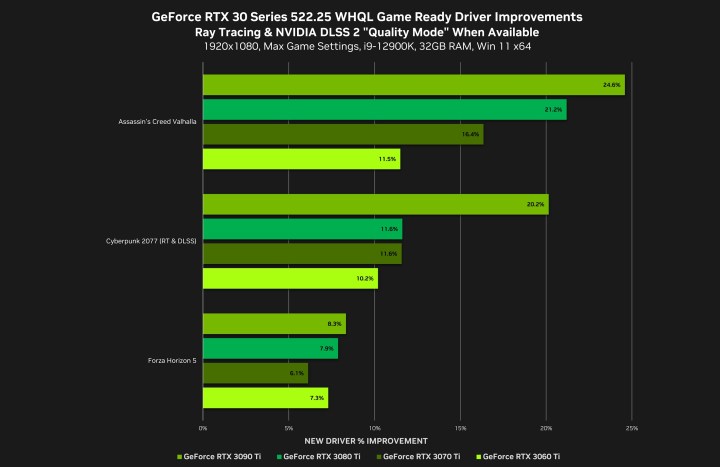Getting a boost to gaming performance is always nice, but it’s even nicer when it’s free — and that’s exactly the case today. Nvidia’s newest DirectX 12 driver, aside from adding support for the new flagship RTX 4090, adds improvements across the board that other gamers can benefit from, too.
Nvidia shared a number of performance figures that show off the improvements delivered by the 522.25 WHQL driver. Several titles will see an upgrade, including Cyberpunk 2077, Assassin’s Creed Valhalla, and Red Dead Redemption 2.

The driver was introduced in order to add support for the RTX 4090, but all owners of an Nvidia GeForce RTX card can benefit from it. While the performance figures will vary depending on your system and the game you’re playing, Nvidia has shared a fairly long list of AAA titles, all of which are seeing some improvements.
In the newest driver, Nvidia has added further optimizations to the way the RTX GPUs handle DirectX 12 games. It targeted shader compilation, added wider resizable BAR support, and attempted to reduce CPU overhead, boosting gaming performance regardless of any processor bottlenecks. Nvidia says that these optimizations will apply to RTX graphics both in desktops and in laptops.
In general, high-end GPUs like the RTX 3090 Ti will see a greater uplift than mid-range options, but even the RTX 3060 Ti scores an 11.5 to 13.9% boost in Assassin’s Creed Valhalla. The majority of the titles delivered a performance boost in 1080p, but there are a couple of 1440p and several 4K options, too. The fact that 1080p is seeing perhaps the biggest improvements is not a bad thing — according to the Steam Hardware Survey for September 2022, 1080p continues to be the most popular display resolution, with 66.38% of Steam gamers using it right now.
According to Nvidia’s own benchmarks, Assassin’s Creed Valhalla may see up to a 24% boost in 1080p; Battlefield 2042 — up to 7%, and Cyberpunk 2077 — up to 20%. Here’s the full list of games alongside Nvidia’s predicted performance metrics.
- Assassin’s Creed Valhalla — 24% (1080p)
- Battlefield 2042 — 7% (1080p)
- Borderlands 3 — 8% (1080p)
- Call of Duty: Vanguard — 12% (4K)
- Control — 6% (4K)
- Cyberpunk 2077 — 20% (1080p)
- F1 22 — 17% (4K)
- Far Cry 6 — 5% (1440p)
- Forza Horizon 5 — 8% (1080P)
- Horizon Zero Dawn: Complete Edition — 8% (4k)
- Red Dead Redemption 2 — 7% (1080p)
- Shadow of the Tomb Raider — 5% (1080p)
- Tom Clancy’s The Division 2 — 5% (1080p)
- Watch Dogs: Legion — 9% (1440p)
These numbers are the maximum values for each benchmark and may be lower depending on your exact GPU and setup. While some of the gains are marginal, it’s all free, which is what makes it a pleasant thing to see even if you’re not buying an RTX 4090 to make the most of it.
If you want to download the new driver, the best way would be to head to Nvidia’s official website or to download GeForce Experience and let the software handle it. We have a quick guide on how to update your GPU drivers if you want to learn more about it.




